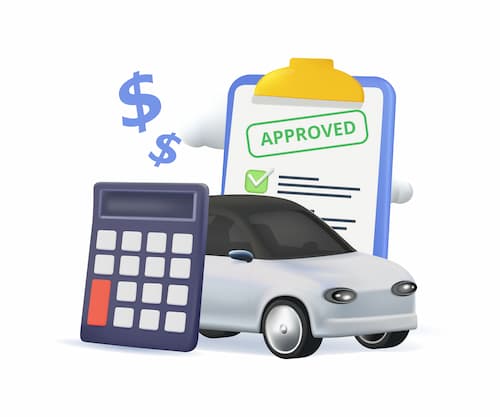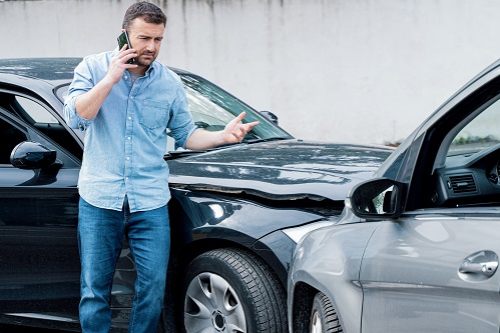What’s the difference between liability and full coverage car insurance?
Liability insuranceLiability insurance covers sums that an insured becomes legally obligated to pay because of bodily injuries or property damage, or financial losses caused to other people. is basic car insurance coverage, and it only pays for damage to others. Purchasing full coverage car insurance will cover you in more situations than liability alone, largely by the addition of coverage for your car.
| Liability-only | Full coverage | |
|---|---|---|
| What is covered? |
|
|
| Average annual cost |
|
|
| Is it mandated by law? |
|
|
| Who is this policy best for? |
|
|
What is liability car insurance?
Liability car insurance pays for injuries and damage to others when you’re financially responsible for an accident that’s your fault.
Each state requires a minimum amount of liability insurance coverage. The most common amounts for liability insurance are 25/50/25. That means $25,000 for bodily injury liability per person, $50,000 for bodily injury liability per accident, and $25,000 for property damage per accident. However, the amounts differ by state and range as low as $10,000 and as high as $100,000.
The state minimum is often too low to cover the cost of even a moderately serious accident. It’s a good idea to consider higher limits.
What is full coverage car insurance?
Full coverage car insurance is a term used for a policy that covers all the standard forms of liability (and any other legally required coverage) and provides additional protections as well, usually collision and comprehensive insurance. Collision insurance covers damage to your car from an accident, and comprehensive covers damage to your car from causes other than an accident. This includes hailstorm damage, a tree falling on your car and theft.
“Full coverage consists of comprehensive and collision,” says Lauren Mckenzie, an insurance agent for A Plus Insurance in South Carolina. “You can add additional coverages such as roadside assistance, rental reimbursement and gap insurance for an additional premiumThe payment required for an insurance policy to remain in force. Auto insurance premiums are quoted for either 6-month or annual policy periods.. Comprehensive covers theft of the vehicle, fire, vandalism, glass breakage, and impact with an animal. Collision covers impact with another vehicle or object. Full coverage is subject to a deductibleThe deductible is the amount you pay out of pocket for a covered loss when you file a claim., which the insured chooses, and the insured will pay the deductible in the event of a claimAn insurance claim is a request you make to your insurance company for coverage after your car is damaged or you have an accident. You can file a claim online, by phone, or in writing. before the insurance company pays out.”
You aren’t obligated to have full coverage, but lenders will require it to get a loan or a lease on a new vehicle. It’s required because it protects the lender’s financial stake in the vehicle.
Liability vs. full coverage: Auto insurance cost comparison
How much more is full coverage than liability-only? It differs from state to state. The state with the smallest increase is Florida, at 65%, based on Insurance.com’s 2023 rate analysis. At the other end, with a 575% increase, is South Dakota. You can expect the cost of liability vs. full coverage to be higher with the latter.
| State | 50/100/50 liability only | 100/300/100 full coverage with $500 comp/coll deductible | $ increase | % increase |
|---|---|---|---|---|
| Alaska | $508 | $1,676 | $1,168 | 230% |
| Alabama | $639 | $1,860 | $1,221 | 191% |
| Arkansas | $589 | $1,957 | $1,368 | 232% |
| Arizona | $764 | $1,812 | $1,048 | 137% |
| California | $864 | $2,416 | $1,552 | 180% |
| Colorado | $717 | $2,337 | $1,620 | 226% |
| Connecticut | $783 | $1,725 | $942 | 120% |
| Washington, D.C. | $785 | $2,157 | $1,372 | 175% |
| Delaware | $1,022 | $2,063 | $1,041 | 102% |
| Florida | $1,629 | $2,694 | $1,065 | 65% |
| Georgia | $789 | $1,970 | $1,181 | 150% |
| Hawaii | $572 | $1,517 | $945 | 165% |
| Iowa | $320 | $1,630 | $1,310 | 409% |
| Idaho | $440 | $1,428 | $988 | 225% |
| Illinois | $471 | $1,532 | $1,061 | 225% |
| Indiana | $498 | $1,515 | $1,017 | 204% |
| Kansas | $471 | $1,900 | $1,429 | 303% |
| Kentucky | $810 | $2,228 | $1,418 | 175% |
| Louisiana | $1,266 | $2,883 | $1,617 | 128% |
| Massachusetts | $655 | $1,726 | $1,071 | 164% |
| Maryland | $756 | $1,746 | $990 | 131% |
| Maine | $341 | $1,175 | $834 | 245% |
| Michigan | $694 | $2,352 | $1,658 | 239% |
| Minnesota | $512 | $1,911 | $1,399 | 273% |
| Missouri | $582 | $1,982 | $1,400 | 241% |
| Mississippi | $637 | $2,008 | $1,371 | 215% |
| Montana | $540 | $2,193 | $1,653 | 306% |
| North Carolina | $523 | $1,741 | $1,218 | 233% |
| North Dakota | $370 | $1,665 | $1,295 | 350% |
| Nebraska | $373 | $1,902 | $1,529 | 410% |
| New Hampshire | $416 | $1,265 | $849 | 204% |
| New Jersey | $915 | $1,902 | $987 | 108% |
| New Mexico | $658 | $2,049 | $1,391 | 211% |
| Nevada | $1,042 | $2,060 | $1,018 | 98% |
| New York | $827 | $1,870 | $1,043 | 126% |
| Ohio | $446 | $1,417 | $971 | 218% |
| Oklahoma | $657 | $2,138 | $1,481 | 225% |
| Oregon | $710 | $1,678 | $968 | 136% |
| Pennsylvania | $504 | $1,872 | $1,368 | 271% |
| Rhode Island | $808 | $2,061 | $1,253 | 155% |
| South Carolina | $925 | $2,009 | $1,084 | 117% |
| South Dakota | $338 | $2,280 | $1,942 | 575% |
| Tennessee | $547 | $1,677 | $1,130 | 207% |
| Texas | $774 | $2,043 | $1,269 | 164% |
| Utah | $756 | $1,825 | $1,069 | 141% |
| Virginia | $477 | $1,469 | $992 | 208% |
| Vermont | $324 | $1,319 | $995 | 307% |
| Washington | $731 | $1,608 | $877 | 120% |
| Wisconsin | $425 | $1,664 | $1,239 | 292% |
| West Virginia | $585 | $2,005 | $1,420 | 243% |
| Wyoming | $331 | $1,758 | $1,427 | 431% |
When should you switch to liability-only car insurance?
There is no specific time you can or should switch to liability-only car insurance. The answer usually depends on the age of your car.
Newer cars, and those with a high value like exotics or high-performance cars, should have full coverage so the owner can recoup as much money as possible in the case of an accident. However, liability-only may be the better financial choice for an older car, especially one that’s paid off. Since an older car has less value if totaled, it’s a trade-off worth looking into.
So, should you get liability or full coverage insurance?
“Once a vehicle gets older than 10 years, the cost for full coverage may be more than what the vehicle would end up being worth in the event of a claim,” McKenzie says. “It is up to the insured if they can afford it and do not mind paying for full coverage for peace of mind. The majority of people will drop down to liability after the vehicle is older than 10 years to avoid paying too much in auto insurance.”
Methodology
Insurance.com commissioned car insurance rates through Quadrant Data Services for state minimum and 50/100/50 liability-only policies, as well as 100/300/100 with comprehensive and collision and $500 deductibles. Rates are based on a 40-year-old male driver with a clean record driving a 2023 Honda Accord LX.



